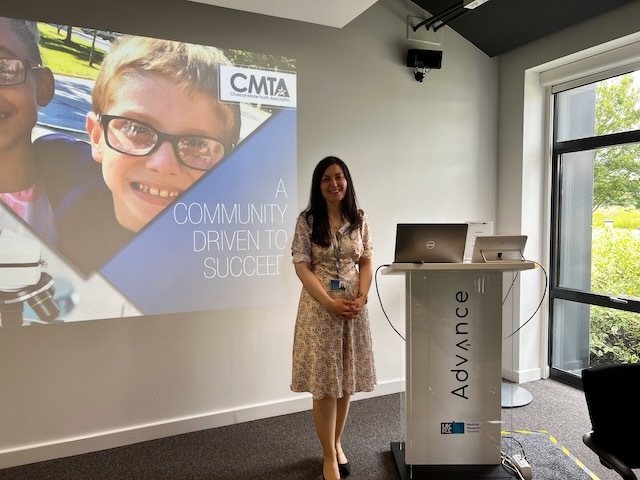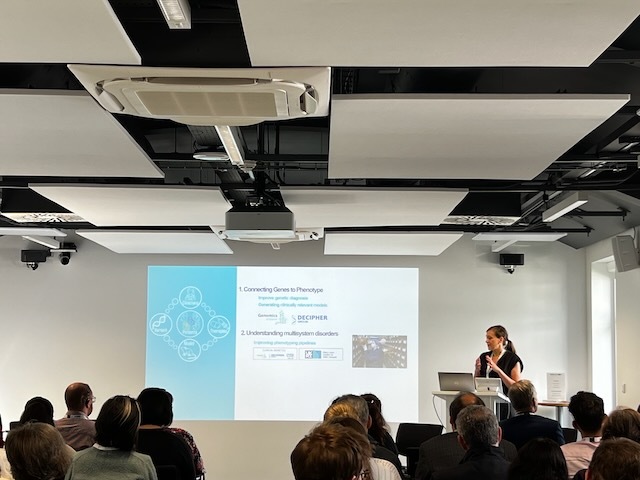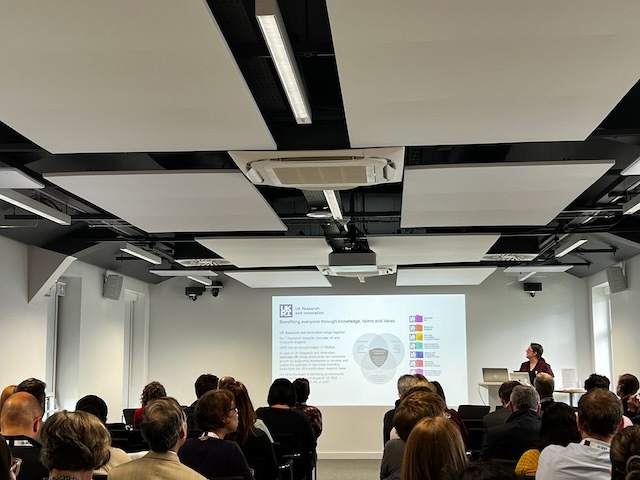Rare Disease Community Event – meeting report

On the 6th of June 2024 the MRC National Mouse Genetics Network (NMGN) and the Mary Lyon Centre at MRC Harwell (MLC) hosted a Resources and Funding Opportunities in Rare Diseases event at the Advance Training Centre aimed at sharing information on resources and funding opportunities in the specific area of preclinical and clinical research and fostering new collaborative initiatives between academia, industry and advocacy/patient groups. It was an ambitious programme put together by Jale Sahin, the Business Development and Partnership Manager at the MLC.

What are the resources on offer?
Lydia Teboul, Head of Molecular and Cell Biology at the MLC, chaired the first session and Sara Wells, Director of the MLC, began proceedings by introducing the centre as the national resource for mouse genetics, describing our academic and corporate partnerships as well as our capacity and flexibility in designing, generating and characterising mutant lines that are relevant to specific preclinical areas of research.
Lydia was then able to introduce one of the most prominent Medical Research Council-funded community programmes run at the MLC. The Genome Editing Mouse for Medicine initiative has been generating clinically relevant mouse mutants for the community for the last 9 years, using the most up-to-date and fully validated genome-editing technologies, and has provided the community with 110 novel mouse strains containing a range of mutation types from simple deletions to complex engineered alleles. The meeting coincides with the opening of the new call, which will focus on mouse strains to be used in the study of rare diseases and will run until the 15th of September 2024. Lydia provided examples of lines generated by the programme that have resulted in high impact publications, further grant applications and international distribution.






Pleasantine Mill, from the NMGN Congenital Anomalies Cluster, highlighted the powerful insights into complex biology provided by patient-led functional genomics. By starting in the clinic with the identification of disease-associated variants, we can develop our understanding of how the genotype contributes to the variability of phenotype. As well as improving genetic diagnosis, this can support the generation of clinically relevant models that allow mechanistic and therapeutic studies. Pleasantine went on to report the example of a primary ciliary dyskinesia (PCD), for which the causative gene mutation was identified following this process. The Variant of Uncertain Significance portal developed by the cluster was also mentioned as one of the resources that can be accessed by the rare disease community in order to facilitate the process.
Nick Lench, Director of the Nucleic Acid Therapies Accelerator (NATA), introduced the mission of the new MRC unit in developing, testing, producing and scaling up production of this new class of drugs that will be usable for both common and rare diseases. He also explained the collaborative model that NATA applies to the funding distribution and provided useful examples of recent initiatives and the way in which NATA’s intervention can leverage further funding. NATA is currently involved in over 40 collaborative projects, including some with the MLC and NMGN, and supports rare disease research, including in ciliopathies, having association with the projects mentioned in the previous talk by Pleasantine Mill.
John Hand, Director of the Research Complex at Harwell (RCaH), described how the MRC-led institute is currently funded by five research councils across UK Research and Innovation (UKRI) and hosts researchers from 46 universities, research facilities and micro SMEs from around the UK, including NATA.
Annie Godwin of the European Xenopus Resource Centre in Portsmouth was keen to point out how Xenopus disease models can be beneficial in tackling the diagnosis bottleneck for rare diseases in which 65% of those affected by a rare disease in the UK will live without a diagnosis, resulting in poor prognosis for their conditions. As over 80% of human disease genes are conserved in frogs and a large proportion of the genome is syntenic with the human genome, editing the frog genome and phenotyping the resulting mutant lines can speed up the process of identification of a causative mutation due to the small size and short generation time of Xenopus compared to other model organisms. Annie provided some examples in which this has been successful and reported that tadpoles have recapitulated human disease phenotypes in more than 90% of the VUS tested in the centre (28 genes).
The session finished with a panel discussion in which an overarching theme of dialogue between different areas of research, clinicians and patients emerged as one of the most important elements to accelerate progress, especially in areas like rare diseases where cohorts are small and potentially highly dispersed geographically.

Funding opportunities
The second session of the day was chaired by the organiser of the meeting, Jale Sahin, and was dedicated to funding opportunities in the rare disease space.
Catriona Crombie from LifeArc, a medical research charity that specialises in translational challenges, highlighted the areas in which this self-funding organisation can assist and partner academics and spin-out companies aiming to find new diagnostic and therapeutic approaches.
Jo Frost from Innovate UK explained how the UKRI-funded organisation supports companies that spin out from UKRI funding to help them scale up and grow. She also went through other international sources of funding that the rare disease community can exploit, focusing most of the attention on Horizon Europe and the areas that the UK has access to.
Victoria Lund from MRC outlined the council’s funding streams and areas of interest, focusing on the support for rare disease research from both the responsive and strategic modes and emphasising how one of the priorities of the Population and Systems Medicine Board is rare diseases.
Finally, Julie Stevens from the Oxford-Harrington Rare Disease Centre a partnership between the University of Oxford and the Harrington Discovery Institute funds over 250 rare disease researchers and 300 spinouts as a global leader in innovation. New calls will open in February 2025.



This was a very informative session in which delegates were able to appreciate the availability of substantial funding in this area, but also identify some obvious gaps that should be filled and could be aided by patient-led charities and advocacy groups.
Examples of successful public-private partnerships in rare diseases
The third and final session was chaired by Nick Lench and was aimed at providing examples in which successful partnerships between public and private sector organisations, including advocacy groups, can lead to positive outcomes. It was kicked off by Katherine Forsey, Chief Research Officer at the Charcot-Marie-Tooth Association (CMTA), who immediately set the tone by emphasising the huge impact that patient-led advocacy groups have on the quantity, quality and focus of the research into their specific disease.




CMT is a clear example of a disease with a significant level of unmet diagnostic and therapeutic needs, which results in a substantial economic burden.
CMTA-sponsored work has led to an accelerated process of discovery for a particular subtype of the disease and their partnership with Applied Therapeutics has resulted in a compound currently in a phase 3 clinical trial benefitting from faster patient recruitment and lobbying as well as access to funds.
Caoimhe Bennett of the Epilepsy Research Institute UK spoke about the chronic underfunding for this disease in comparison to other neurological disorders and highlighted the research priorities of the institute.
She introduced their researchers’ hub, which aims to bring together researchers in the field and encourages the sharing of new findings, funding calls and job opportunities, and their Shape Network, which is the UK’s largest group of research-interested people affected by epilepsy. This patient-led advocacy group has three main purposes: learn about the science of epilepsy, participate in research studies and shape research priorities. The institute also partners with NATA to award the ERI & NATA fellowship award to develop future leaders in epilepsy research.
Neil Watson of the Northern Alliance Advanced Therapies Treatment Centre concluded the speakers’ section of this session and introduced the work of the centre in developing and supplying systems for the routine delivery of new disruptive therapies such as car-T therapy, developed in collaboration with London Advanced Therapies.
How do we overcome the challenges?
A final panel discussion tackled the issue of joining efforts between patient advocacy groups on one side and academic/industry organisations that carry out research and therapy development and delivery on the other.
Is it possible to formalise and streamline this process to speed up positive outcomes, especially when tackling legal hurdles such as intellectual property (IP) that often hold up progress and frustrate the community?
How do we also make new treatments available to less wealthy countries?
The economic burden of rare diseases is also a difficult parameter to assess, due to the fragmented nature and small size of individual disease groups, and could be aided by the development of new models using artificial intelligence that would be scaled across many diseases to be of greater influence, but this would need a major effort in improving records for all rare diseases, not just those with well-funded and more powerful advocacy groups. This could be achieved with better integration of NHS data.
This was a stimulating discussion with many ideas and proposals put forward and a clear indication that communication between the different elements of the rare disease community is possibly the most powerful tool with which to solve this very complex puzzle.

Networking followed before delegates made their way back home with many new possibilities for future work together.